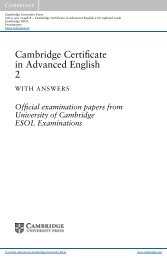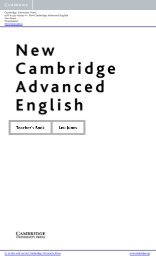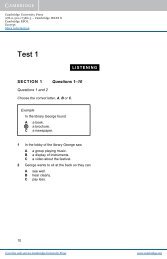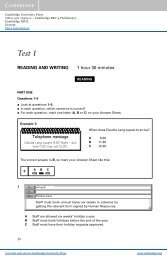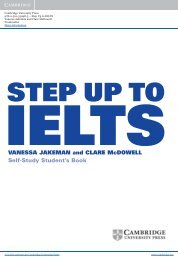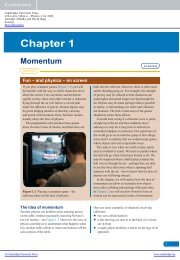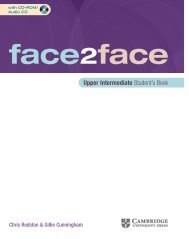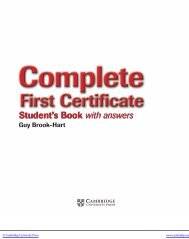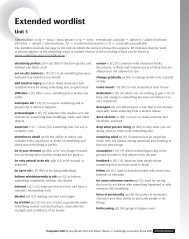Skills for Study Level 2 Teacher's Book - Cambridge University Press
Skills for Study Level 2 Teacher's Book - Cambridge University Press
Skills for Study Level 2 Teacher's Book - Cambridge University Press
You also want an ePaper? Increase the reach of your titles
YUMPU automatically turns print PDFs into web optimized ePapers that Google loves.
Note: In the next series of activities, students practise intensive reading by readingand comparing slightly different versions of otherwise identical texts. The changesare limited to one or two words in most cases, but have a potentially significantimpact on the author’s argument or apparent stance.2cAnswersMain idea:Italy produced the most realistic and beautiful art during the fifteenth andsixteenth centuries through using inspiration from classical Rome (proportion)and new scientific techniques (perspective).Supporting in<strong>for</strong>mation:This period is called the Renaissance (revival) in reference to the rediscovery ofclassical knowledge and <strong>for</strong>ms in art. Italian Renaissance artists aimed to maketheir art represent reality.How Italian artists made their paintings realistic:Italian art captured genuine images of the human <strong>for</strong>m. They used classicalknowledge about proportion and contemporary scientific or mathematicaldiscoveries about perspective.The style of painting in Northern Europe:According to the writer, the Renaissance had no effect on Northern Europeanart, which was flat and less true-to-life than in Italy. Jan Van Eyck’s art in theNetherlands aimed to create realism, but was less effective and beautiful thanItalian art as he didn’t use teachings on perspective and proportion.2d Note: Changes in Text B are underlined in the text below, with the implications ofthose changes written in italics.AnswersText BEurope created beautiful, and realistic, art in the fifteenth and sixteenth centuries (thewhole of Europe, not just Italy). This period is known as the Renaissance, or ‘revival’,because it moved away from the less life-like art of the Middle Ages (the periodbetween the Classical Age of ancient Greece and Rome, and the Renaissance)and revived the more true-to-life art of classical times (the language is more neutraland cautious here. It is less dismissive of art of the Middle Ages). Classical art wasthought to be more ‘real’ than art in the Middle Ages because it aimed to capturea genuine image of the human <strong>for</strong>m: people looked like real people (again, morecaution used here). Renaissance artists revived this reality, or ‘truth’, in their art,with classical writing on proportion and contemporary Italian scientific discoveriesabout perspective, helping to make this possible (the other text says that proportionand perspective were the ‘only’ way this was possible; this text is more open to theidea that other techniques helped to create beautiful and realistic art). Mathematicsassisted artists in the recreation of nature’s beauty in sculpture, architectureand paintings: human beings could be represented with accurate proportions;landscapes could be recreated on flat walls as though a window had been openedto the world (more caution here, and no emphasis just on Italian artists). At the sametime, art in Northern Europe was less affected by Renaissance teachings (caution:suggestion that it was affected, but not as strongly as in other places). While someart continued to be created in a flat, less true-to-life, manner, Jan van Eyck (1390?–1441), of the Netherlands, did try to make his paintings realistic (suggestion that vanEyck not following tradition of Dutch art of the Middle Ages, whereas the other textsuggests that his art still inferior to Italian). He copied minute detail such as individualhairs in an animal’s fur and strands in a tapestry to make his images seemUnit 4 Part B ∙ Understanding written in<strong>for</strong>mation 112



